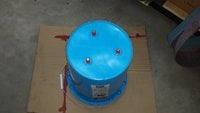It fit in the jug I wanted to useIs there a reason in your winter waterer design you opted for an aquarium heater over a de-icer?
 and I had read about someone using one successfully.
and I had read about someone using one successfully.Follow along with the video below to see how to install our site as a web app on your home screen.
Note: This feature may not be available in some browsers.
It fit in the jug I wanted to useIs there a reason in your winter waterer design you opted for an aquarium heater over a de-icer?
 and I had read about someone using one successfully.
and I had read about someone using one successfully.




Should have used the submersible heater with the HN's.
Ever used/built a device to record(graph output) multiple heat probes?
Would be interesting to see the temps at various heights inside bucket with either heater.
So, most stock tank heaters that I know of have their own thermostat that is set to 33-35° F. In my experience, they don't heat the water enough to radiate heat out to keep either style of nipple from freezing. I completely respect that others don't care for aquarium heaters, but they just work for me.I tried horizontal nipples with a floating stock tank heater in a plastic 5 gallon bucket exposed to the wind but they kept freezing up. So I went back to the vertical nipples and a submersible heater and just added some insulation foam around the nipples then cut the bottom 3" off another bucket and placed that over the insulation to protect the insulation from chicken pecking. So the only thing that sticks out is the metal pin. Works for me in the open air down to 0°F so far. I have a thread here...
View attachment 1627290
View attachment 1627288
View attachment 1627287
View attachment 1627286
JT
So, most stock tank heaters that I know of have their own thermostat that is set to 33-35° F. In my experience, they don't heat the water enough to radiate heat out to keep either style of nipple from freezing. I completely respect that others don't care for aquarium heaters, but they just work for me.